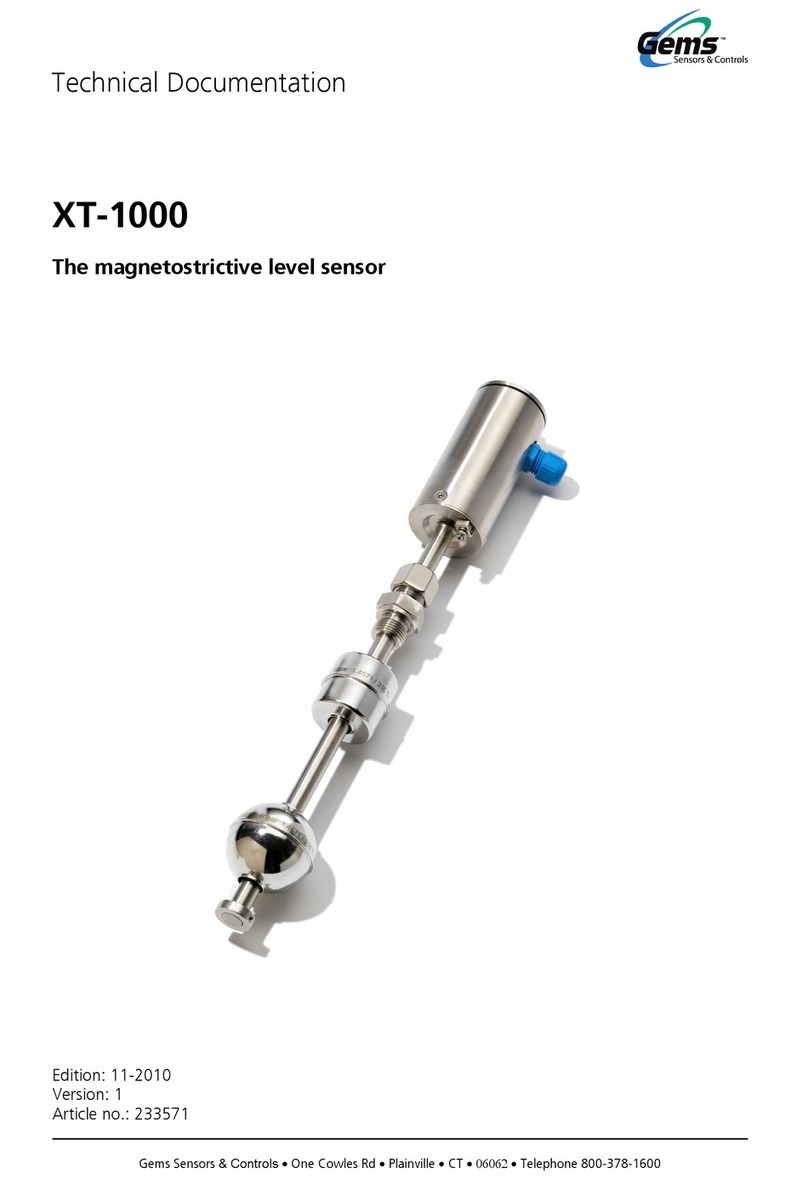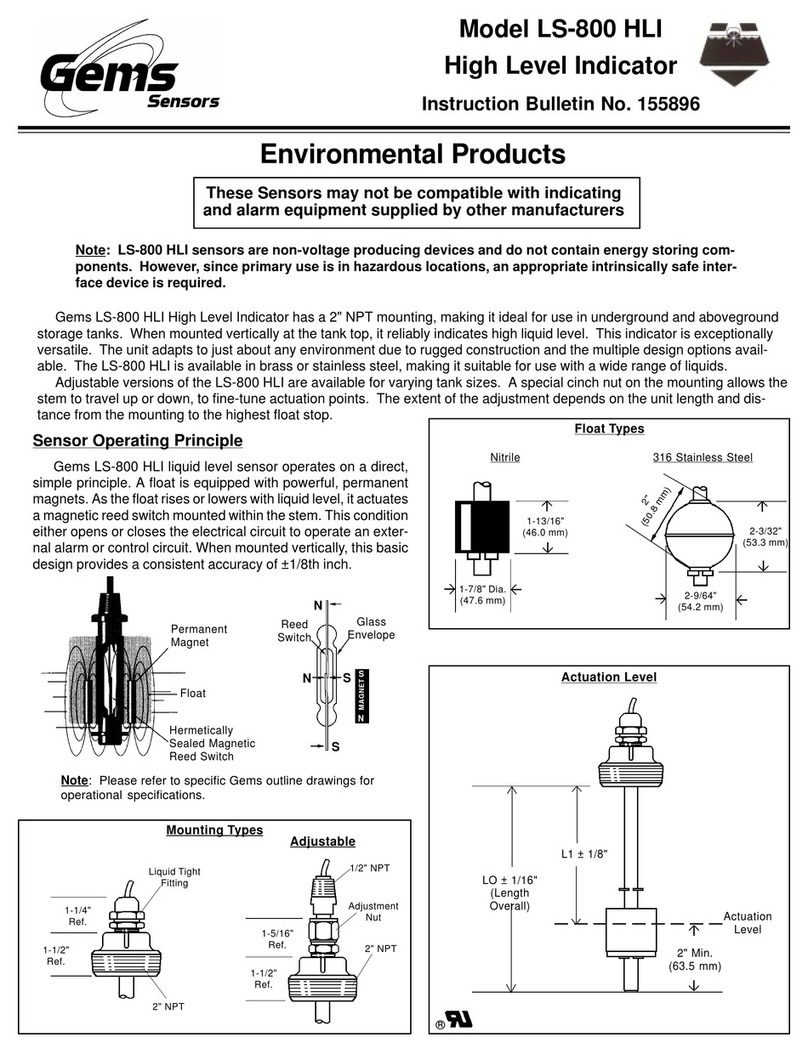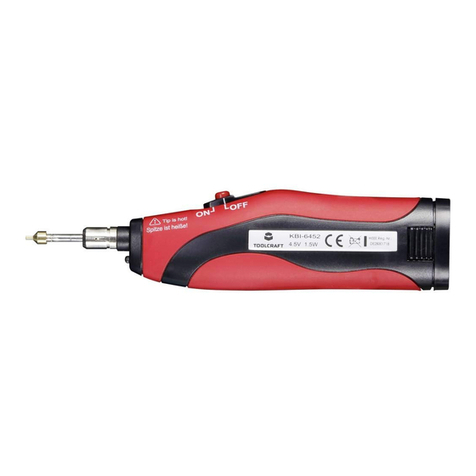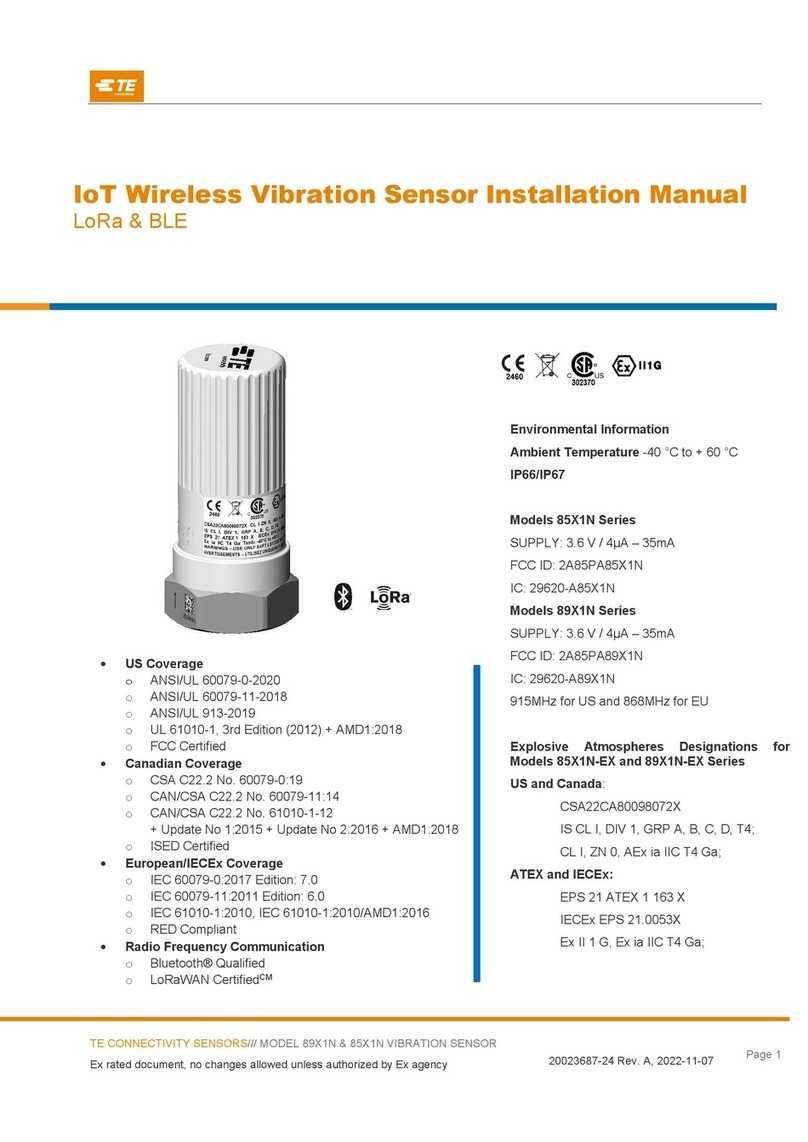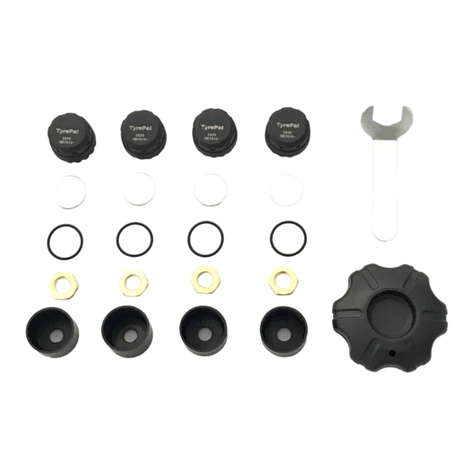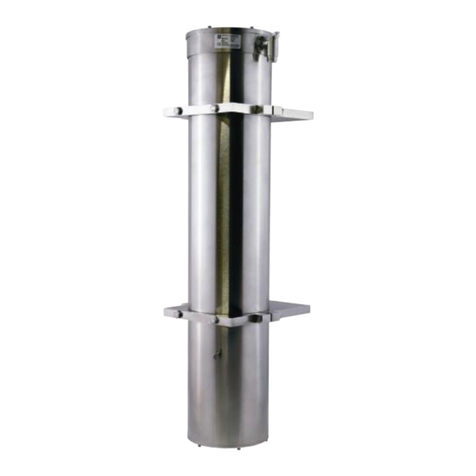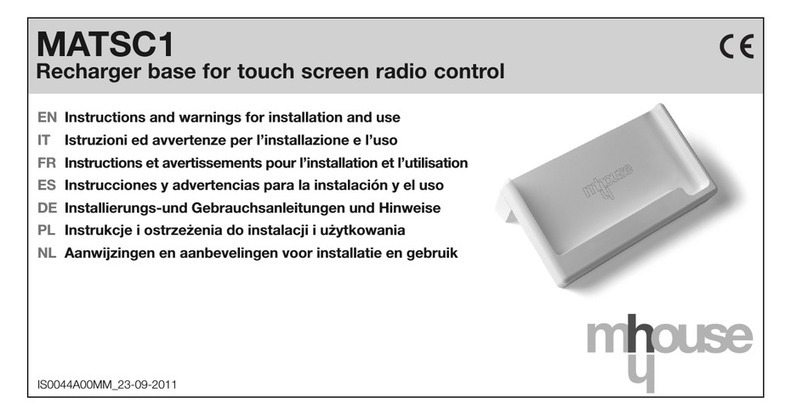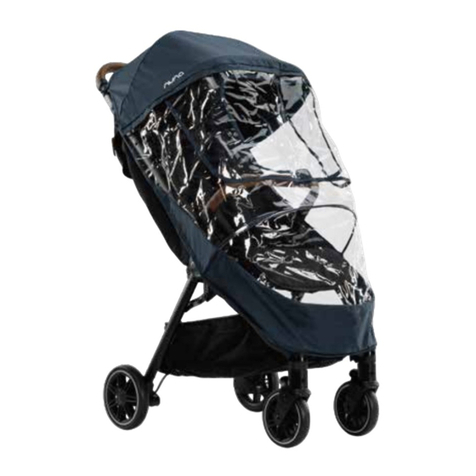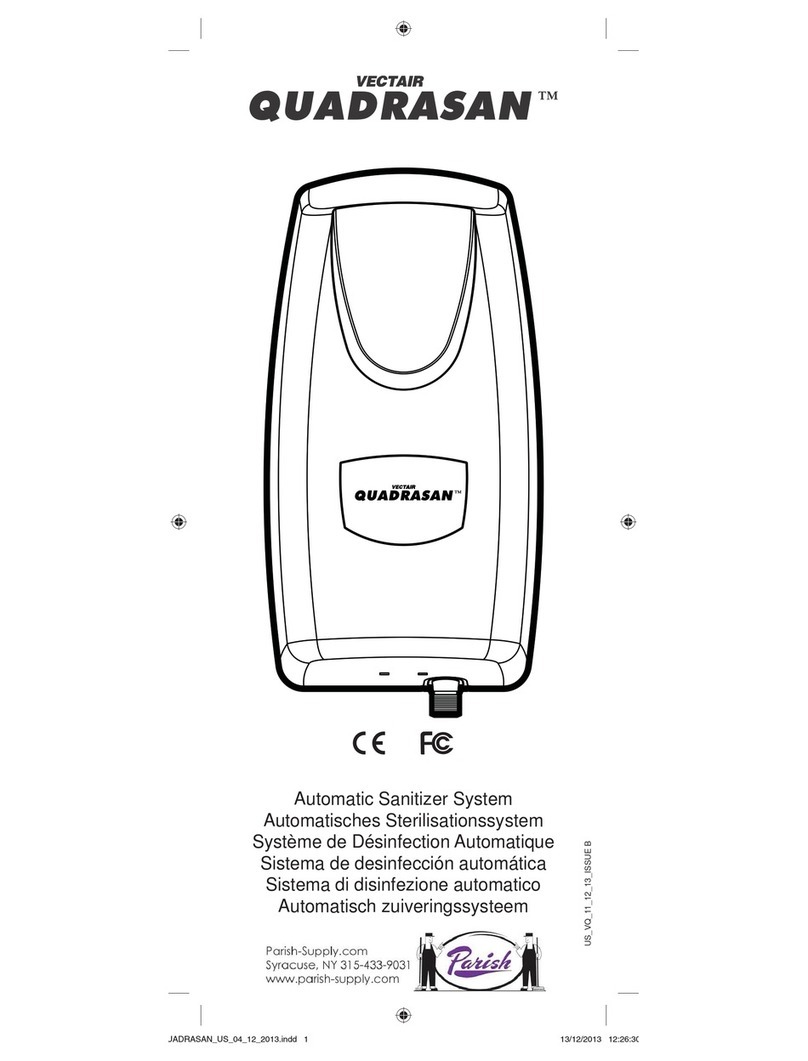Gems RotorFlow RFS-2500 Series Training manual

Instruction Bulletin No.
157261
Rev. G
RFS-2500 Series
RotorFlow® Sensors
(For A itional Information, See Gems' "Level, Flow an Pressure Catalog)
RotorFlow units monitor ynamic flui flow. The rotor reacts to
turbulence, pulsation, entraine air, an other flow anomalies in uce in
the flow stream by other process har ware. For optimum performance,
install RotorFlow units where nominal flow con itions exist, with ports
locate at the top. Incoming flow may be place to either port. A
minimum of 8" of straight pipe on the inlet si e is recommen e .
Low Flow Applications
A low flow a apter is supplie with all RotorFlow units. It is use to pro uce accurate response at low flow rates. Press fit the
a apter as shown above, in the port selecte for incoming flow. See Flow Range Chart below.
*
With use of low flow
a apter supplie
**
Straight threa with O-
ring seal
Stan ar Low Flow*
Bo y
Material
Port Size
NPT
Input
Power
Part
Number Range Range A apter
Part Number
Polypropylene
.25"
12 VDC 155424
0.5 - 5.0 0.1 - 1.0 152147
24 VDC 155425
110 VAC 155876
.50"
12 VDC 155484
4.0 - 20.0 1.5 - 12.0 151832 24 VDC 155485
110 VAC 155886
Brass
.25"
12 VDC 156264
0.5 - 5.0 0.1 - 1.0 152147 24 VDC 156265
110 VAC 156266
.50"
12 VDC 156267
4.0 - 20.0 1.5 - 12.0 151832
24 VDC 156268
110 VAC 156269
.75"
12 VDC 180394
5.0 - 30.0 N/A N/A
24 VDC 180395
110 VAC 180396
1.0"
24 VDC 181688
8.0 - 60.0 N/A N/A
115 VAC 181689
316 Stainless
Steel
9/16”-18** 24 VDC 165073 0.5 - 5.0 0.1 to 1.0 152147
110 VAC 165074
.50” 24 VDC 165077 4.0 to 20.0 1.5 to 12.0 151832
110 VAC 165078
.75” 24 VDC 5.0 - 30.0 N/A N/A
115 VAC 181692
1.0”
24 VDC 181693
8.0 - 60.0 N/A N/A
115 VAC 181694
181691
Flow Range-GPM

Installation: RotorFlow sensors connect to piping via NPT mating threa s forms. The following gui elines are
provi e to assist with installation for a leak-free seal, without amage to the unit: 1) Apply pipe threa sealant to male
pipe threa s. 2) Threa RotorFlow unit onto male pipe threa until hang-tight . 3) Tighten pipe 1 to 1/2 a itional turns.
4) If improper seal results, continue turning pipe into unit in 1/4 turn increments. Do not excee one a itional turn.
Recommen e pipe Sealants:
(a) Permatex® “ No More Leaks” (b) Teflon® Threa Tape.
Filtration an Cleaning: 150 micron filtration is recommen e . However, shoul foreign particles enter the
RotorFlow sensor, accumulation is easily cleare by removing the lens from the bo y. The lens is remove by turning
its center rib 45°C counter-clockwise an then pulling it out. To reinstall the lens, simply reverse the process.
Pressure must be relieve from the system prior to sensor clean-out.
Panel Mounting
Any RotorFlow sensor may be panel mounte using holes integrate into the bo ies.
Plastic Bo ies
Two (2) mounting ears are provi e at the bo y centerline to receive #8 Self- tapping screws.
(
Brass an stainless steel bo -
ies use 8-32 UNC2B screws.).
See recommen e panel preparation iagram. Note: ANSI T Type 23 self-tapping screws are recommen e for plastic.
They may be replace with stan ar machine screws if reinstallation shoul be require .
Plastic, Brass , Stainless Steel Brass/Stainless Steel
1/4”, 1/2”, 9/16”-18 3/4” & 1”
Note
A RotorFlow Repair Kit is available, inclu ing the following replacement
parts: lens, O-ring, shaft, an rotor. Consult Factory to or er.

Switch Set Point Calibration with LED Signal
With the unit installe in the line an power supplie , complete the following steps to calibrate switch actuation point with
proper flow rate. A small flat-bla e screw river is all that is require .
1. A just liqui flow in the line to the
rate at which actuation is esire .
2. Insert screw river into opening on
backsi e of housing an fit bla e into
the potentiometer a justment screw
insi e.
3. If LED is not illuminate , slowly turn
screw river counter-clockwise an
stop as soon as LED illuminates.
4. If LED is illuminate , turn screw river
clockwise until LED light goes out.
Then, slowly turn screw river
counter-clockwise an stop as soon
as LED illuminates.
Specifications
†
Hy rolytically stable, glass-reinforce , Polypropylene is UL-recognize to UL746B at a
relative temperature in ex of 65°C
Wetted Materials
Body Brass, 316 SS or Polypropylene, Hydrolytically Stable, Glass-Reinforced
†
Rotor Pin Ceramic
Rotor PPS Composite/Teflon/PPS Composite
Lens Polysulfone
O-Ring Buna N/Viton
Operating Pressure, Max. Brass
Body & 316 SS Body 200 PSIG @ 70°F 80 PSIG @ 212°F
100 PSIG @ 70°F 40 PSIG @ 212°F
212°F (100°C)
Polypropylene Body 180°F (82.2°C)
316 SS Body 212°F (100°C)
Electronics (All Bodies) 150°F (65.5°C)
Viscosity, Max. 200 SSU
Input Power 12 VDC, 24 VDC or 110 VAC
Relay Contact Ratings (SPDT) 1 Amp, 24 VDC Resistive 0.3 Amp, 110 VAC
Repeatability 2% Maximum Deviation
Set Point Accuracy (Factory Set) ±5%
Set Point Differential 15% Maximum
Electrical Termination 22 AWG PVC-Jacketed, 24" Cable. Color codes: Red = +VAC/VDC;
Black = Grou d; White = N.O. Co tact; Brow = N.C. Co tact; Gree = Commo .
Polypropylene Body
Operating Temperature, Max.
Brass Body

Electrical Data
Input power an output are connecte via a
Multi-con uctor, PVC-jackete 24” cable.
Color co es are as shown below:
This pro uct is suitable for Class I an Class II applications only, per the requirements of stan ar EN60730 an any a itional specific
requirements for a particular application or me ium being sense . Class I compliance of metal bo ie units requires a groun
connection between the metal bo y an the earthing system of the installation. Class I compliance of plastic bo ie units in contact
with a con uctive me ium requires that the me ium be effectively earthe so as to provi e an earthe barrier between the unit an
accessible areas. For Class III compliance, a supply at safety extra-low voltage (SELV) must be provi e . Please consult the Factory
for compliance information on specific part numbers.
+VAC/VDC Re
-Power Black
N.O. Contact White
N.C. Contact Brown
Common Green
WARNING
When etermining chemical compatibility of
materials of construction, the flow me ia an
application-associate environmental con itions
shoul be carefully consi ere .
Pro uct must be maintaine an installe in strict
accor ance with the National Electrical Co e an GEMS
pro uct catalog an instruction bulletin. Failure to observe
this warning coul result in serious injuries or amages.
Pressure an temperature limitations shown on in ivi ual
catalog pages an rawings for the specifie flow
switches must not be excee e . These pressures an
temperatures take into consi eration possible system
surge pressures/temperatures an their frequencies.
Selection of materials for compatibility with the me ia is
critical to the life an operation of GEMS flow switches.
Take care in the proper selection of materials of
construction; particularly wette materials.
Life expectancy of switch contacts varies with
applications. Contact GEMS if life cycle testing is
require .
Ambient temperature changes o affect switch set
points, since the specific gravity of a liqui can vary
with temperature.
Flow switches have been esigne to resist shock an
vibration; however, shock an vibration shoul be
minimize .
Liqui me ia containing particulate an /or ebris
shoul be filtere to ensure proper operation of
GEMS pro ucts.
Electrical entries an mounting points may require
liqui /vapor sealing if locate in an enclose tank.
Flow switches must not be fiel repaire .
Physical amage sustaine by the pro uct may
ren er it unserviceable.
Important Points!
Gems Sensors & Controls | One Cowles Roa | Plainville, CT 06062-1198
Telephone: 1-800-378-1600 | Email: [email protected] | www.GemsSensors.com
Table of contents
Other Gems Accessories manuals
Popular Accessories manuals by other brands
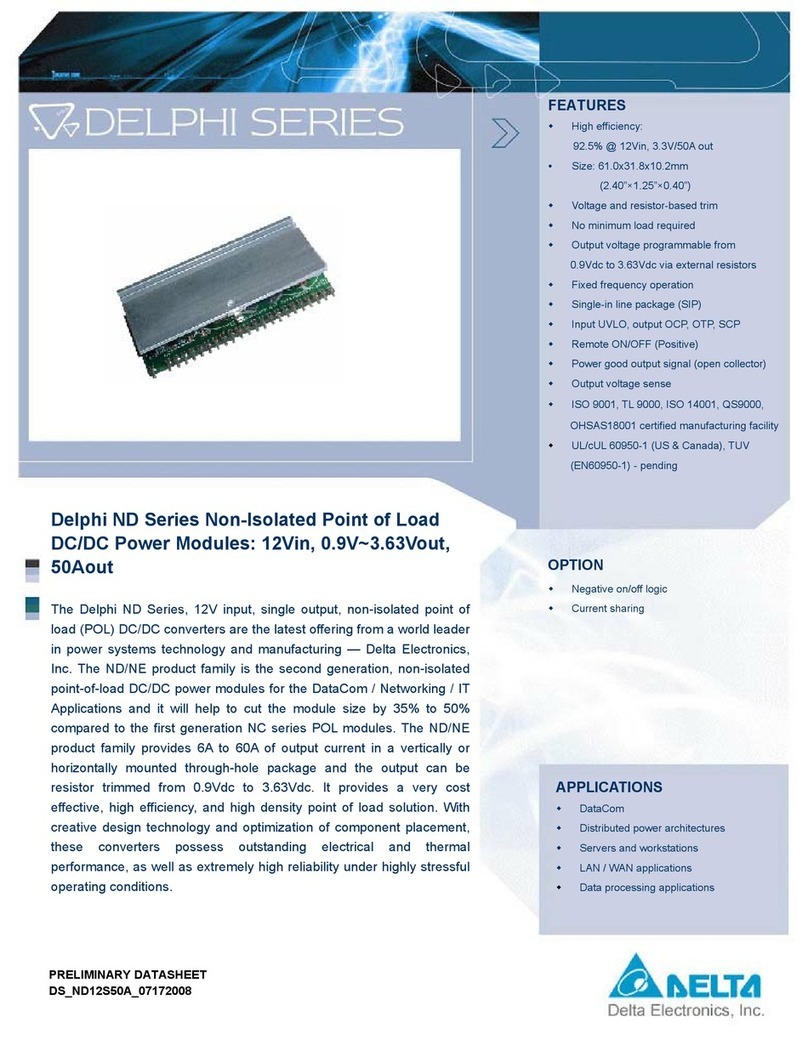
Delta Electronics
Delta Electronics Delphi ND Series Specification sheet
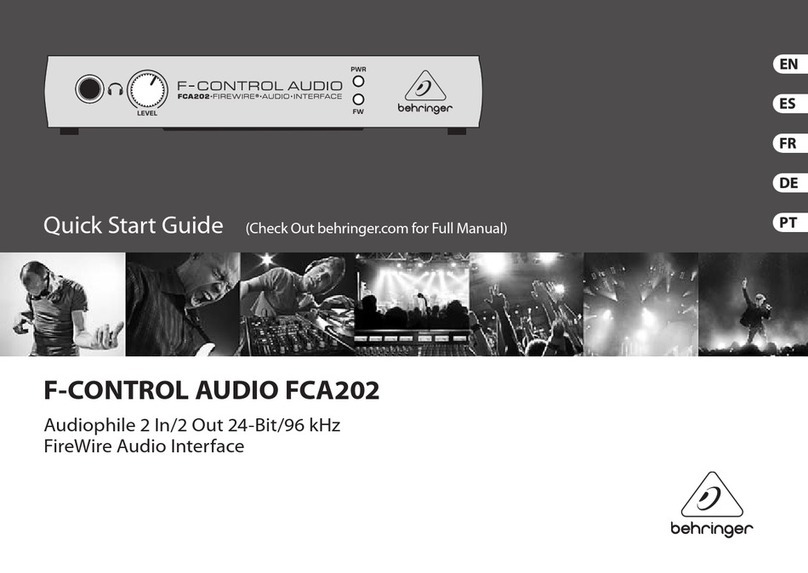
Behringer
Behringer F-Control Audio FCA202 quick start guide
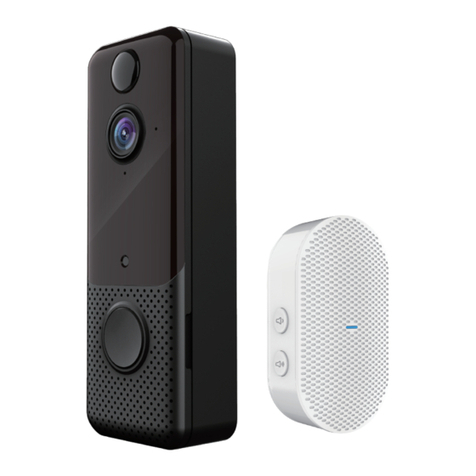
KAMEP
KAMEP T8 user manual
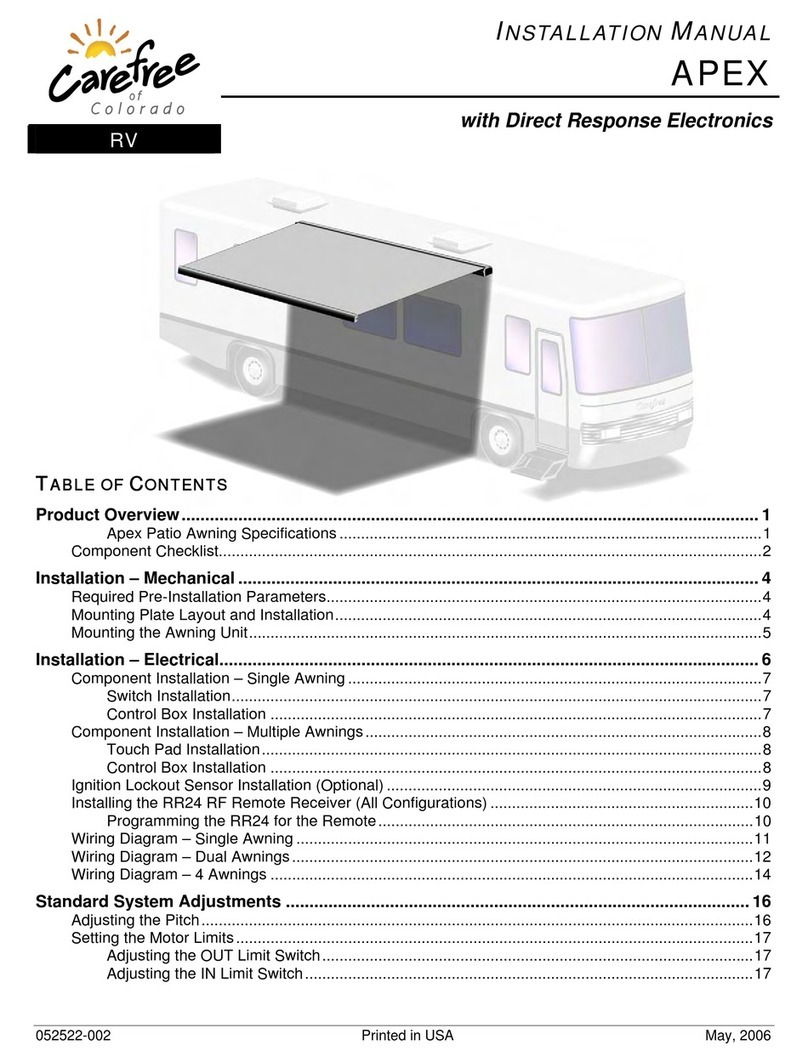
Carefree of Colorado
Carefree of Colorado APEX installation manual
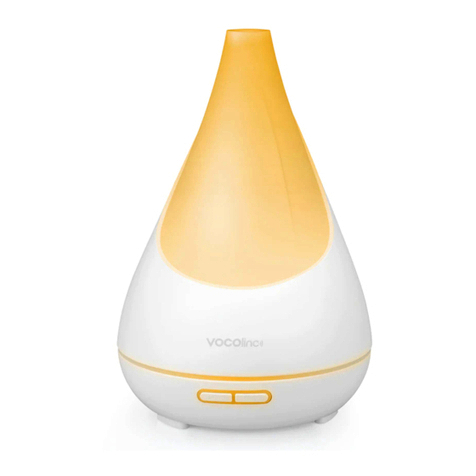
VOCOlinc
VOCOlinc FLOWERBUD SMART DIFFUSER quick start guide

Hotron
Hotron SSS-5 Quick installation guide
